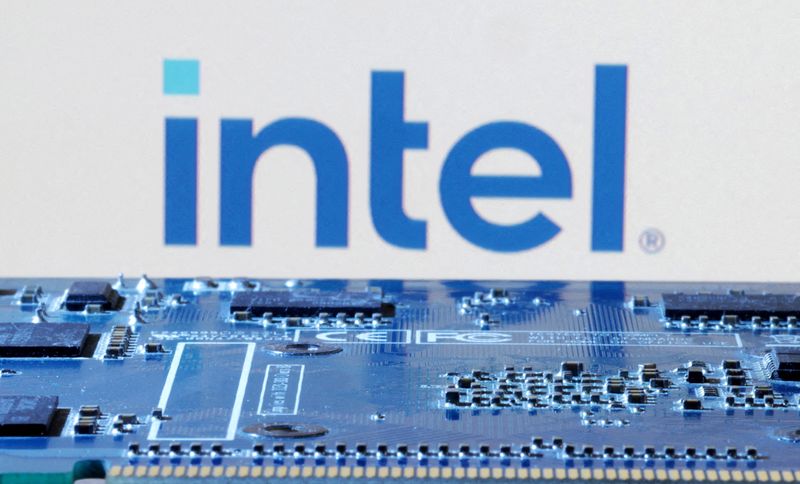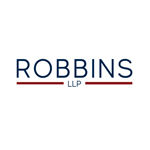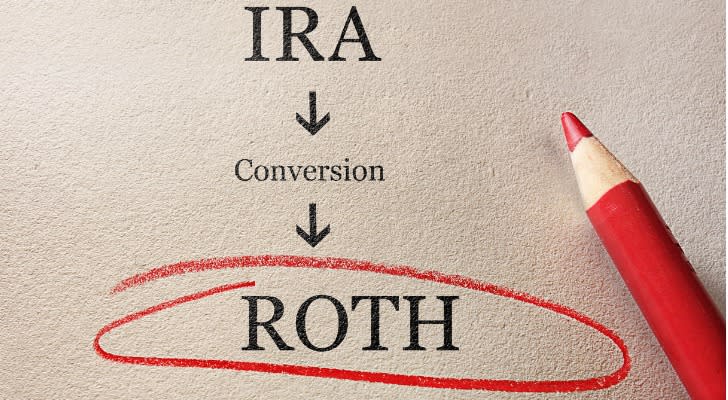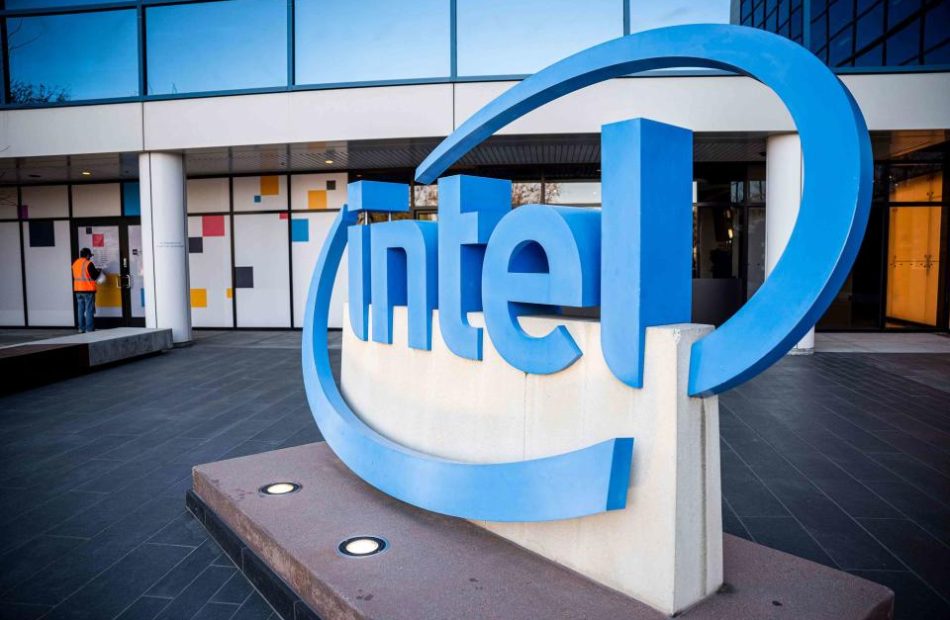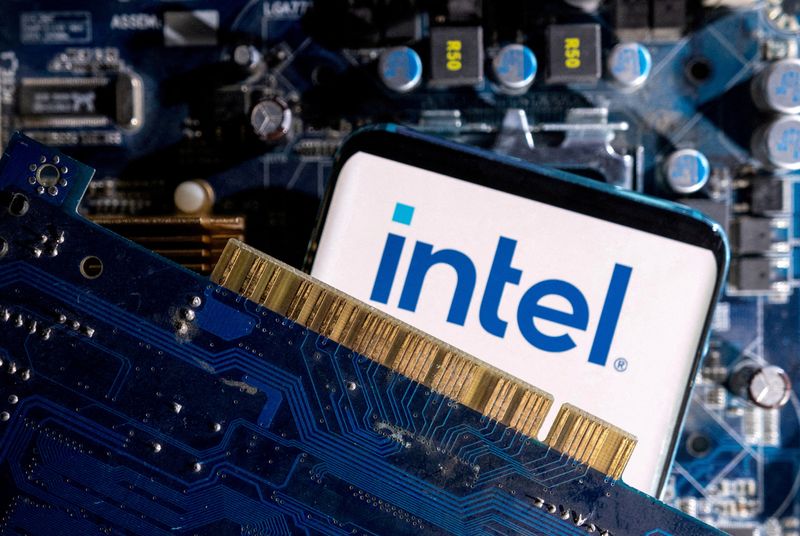Intel manufacturing business will see 'meaningful' revenue in 2027, CFO says
By Max A. Cherney
(Reuters) – Intel will begin to generate a “meaningful” amount of revenue from its contract chip manufacturing business in 2027, the company’s CFO said at an investor conference on Wednesday.
Intel is currently in talks with 12 potential customers that finance chief David Zinsner said will generate some revenue in 2026 and additional cash in 2027. The company has decided not to market its 20A manufacturing process in favor of focusing on the more advanced 18A manufacturing process, the CFO said.
The foundry business currently generates revenue from its advanced packaging business, Zinsner said.
Zinsner did not directly address a Reuters report on Wednesday about Intel failing to produce viable test wafers for Broadcom, a potential manufacturing customer.
The Santa Clara, California-based company is amid a turnaround plan that includes shedding a number of businesses and a 15% cut to its staff. CEO Pat Gelsinger and other key executives are expected to present plans to the company’s board of directors at a mid-September meeting, Reuters reported on Sunday.
Cuts to the company will mostly be completed by the time Intel announces the current quarter’s earnings, Zinsner said. The company is considering a wide range of options as it ponders what to cut or keep.
The company is “not likely to see money” until the end of the year from the U.S. CHIPS Act, Zinsner said. The act is allocating billions in grants and other incentives to spur chip manufacturing in the United States.
(Max Cherney in San Francisco; Editing by Chris Reese and Mark Porter)
DAVA Class Action Notice: Robbins LLP Reminds Stockholder of the Endava PLC Class Action
SAN DIEGO, Sept. 04, 2024 (GLOBE NEWSWIRE) — Robbins LLP reminds investors that a shareholder filed a class action on behalf of all persons and entities that purchased or otherwise acquired Endava PLC DAVA securities between May 23, 2023 and February 28, 2024. Endava provides technology services for clients in consumer products, healthcare, mobility, and retail verticals in North America.
For more information, submit a form, email attorney Aaron Dumas, Jr., or give us a call at (800) 350-6003.
The Allegations: Robbins LLP is Investigating Allegations that Endava PLC (DAVA) Misled Investors Regarding its Business Prospects
According to the complaint, during the class period, defendants failed to disclose to investors that: (1) demand for the Company’s services was declining; (2) the Company’s clients delayed or canceled projects; (3) as a result, the Company’s fiscal 2023 and 2024 revenue and earnings would be adversely affected; and (4), as a result, Defendants’ positive statements about the Company’s business, operations, and prospects were materially misleading and/or lacked a reasonable basis.
On February 29, 2024, Endava issued a press release reporting disappointing financial results for second quarter 2024, announcing a disappointing outlook for third quarter and full fiscal year 2024, and noting that some of the Company’s clients had delayed their orders due to economic uncertainty. On this news, the price of Endava’s ADS plummeted $26.65, or nearly 42%, to close at $37.17.
What Now: You may be eligible to participate in the class action against Endava PLC. Shareholders who want to serve as lead plaintiff for the class must submit their application to the court by October 25, 2024. A lead plaintiff is a representative party who acts on behalf of other class members in directing the litigation. You do not have to participate in the case to be eligible for a recovery. If you choose to take no action, you can remain an absent class member. For more information, click here.
All representation is on a contingency fee basis. Shareholders pay no fees or expenses.
About Robbins LLP: Some law firms issuing releases about this matter do not actually litigate securities class actions; Robbins LLP does. A recognized leader in shareholder rights litigation, the attorneys and staff of Robbins LLP have been dedicated to helping shareholders recover losses, improve corporate governance structures, and hold company executives accountable for their wrongdoing since 2002. Since our inception, we have obtained over $1 billion for shareholders.
To be notified if a class action against Endava PLC settles or to receive free alerts when corporate executives engage in wrongdoing, sign up for Stock Watch today.
Attorney Advertising. Past results do not guarantee a similar outcome.
A photo accompanying this announcement is available at https://www.globenewswire.com/NewsRoom/AttachmentNg/192943a4-e9d0-4ca8-af09-c2200329d816

Market News and Data brought to you by Benzinga APIs
© 2024 Benzinga.com. Benzinga does not provide investment advice. All rights reserved.
SCENTRE GROUP ANNOUNCES PRELIMINARY EARLY RESULTS OF TENDER OFFER
NEW YORK and SYDNEY, Sept. 4, 2024 /PRNewswire/ — RE1 Limited, in its capacity as responsible entity and trustee of Scentre Group Trust 2 (the “Offeror”), a trust forming part of the stapled entity Scentre Group SCG (“Scentre Group”), announced today the preliminary early tender results for its previously announced tender offer (the “Tender Offer”) for up to US$550 million aggregate principal amount (the “Maximum Tender Amount”) of its outstanding Subordinated Non-Call 6 Fixed Rate Reset Notes due 2080 (the “Notes”). The terms and conditions of the Tender Offer are set forth in the Offer to Purchase dated August 20, 2024 (the “Offer to Purchase”).
Preliminary Early Tender Results
As of 5:00 p.m., New York City time, on September 4, 2024 (the “Early Tender Time”), according to preliminary information provided by Global Bondholder Services Corporation, the tender and information agent for the Tender Offer, the aggregate principal amount of the Notes set forth in the table below under “Principal Amount Tendered as of Early Tender Time” had been validly tendered in the Tender Offer. Withdrawal rights for the Notes expired at 5:00 p.m., New York City Time, on September 4, 2024.
The amount tendered satisfied the Minimum Tender Condition and exceeded the Maximum Tender Amount. Scentre Management Limited, in its capacity as responsible entity and trustee of SGT1, intends to conduct an offering of new subordinated debt securities to certain institutional investors outside the United States (the “Financing Transaction”). As described in the Offer to Purchase, the amount of Notes the Offeror will repurchase in the Tender Offer depends on the outcome of the Financing Transaction, and the Offeror may, but is under no obligation to, increase the Maximum Tender Amount. The Offeror will announce the results of the Financing Transaction and the amount it intends to repurchase in the Tender Offer after pricing of the Financing Transaction.
|
Title of Security |
CUSIP Nos. and ISINs |
Principal Amount Outstanding |
Principal Amount Tendered as of Early Tender |
|
Subordinated Non-Call 6 Fixed |
144A CUSIP: 76025LAA2 144A ISIN: US76025LAA26 |
US$1,387,955,000 |
US$771,711,000 |
The Tender Offer is being made pursuant to the Offer to Purchase which sets forth a more detailed description of the Tender Offer. The Tender Offer will expire at 5:00 p.m., New York City time, on September 19, 2024, or any other date and time to which the Offeror extends the Tender Offer, unless earlier terminated. The Offeror urges holders of the Notes to read the Offer to Purchase carefully before making any decision with respect to the Tender Offer. The Offer to Purchase may be obtained at www.gbsc-usa.com/scentre/ or by contacting the tender and information agent using the telephone number or email address found below under “Dealer Managers and Tender and Information Agent”.
Dealer Managers and Tender and Information Agent
The Offeror has appointed Merrill Lynch International, RBC Capital Markets, LLC and SMBC Nikko Capital Markets Limited as dealer managers (the “Dealer Managers”) for the Tender Offer. The Offeror has retained Global Bondholder Services Corporation as the tender and information agent for the Tender Offer. For additional information regarding the terms of the Tender Offer, please contact: Merrill Lynch International at +44 207 996 5420 (international) or +1 (980) 387-3907 (in the U.S.) or +1 (888) 292-0070 (U.S. toll-free) or DG.LM-EMEA@bofa.com (email) or RBC Capital Markets, LLC at (212) 618-7843 (in the U.S.) or (877) 381-2099 (U.S. toll-free) or liability.management@rbccm.com (email) or SMBC Nikko Capital Markets Limited at + 44 204 507 5043 or liability.management@smbcnikko-cm.com (email). Requests for documents and questions regarding the tendering of Notes may be directed to Global Bondholder Services Corporation by telephone at (212) 430-3774 (for banks and brokers only), (855) 654-2015 (toll-free) or 001-212-430-3774 (international), by email at contact@gbsc‑usa.com or at https://www.gbsc-usa.com/scentre/.
This press release shall not constitute, or form part of, an offer to sell, a solicitation to buy or an offer to purchase or sell any securities. The Tender Offer is being made only pursuant to the Offer to Purchase and only in such jurisdictions as is permitted under applicable law.
Neither the Offer to Purchase nor any disclosure document (as defined in the Australian Corporations Act 2001) in relation to the Notes has been or will be lodged with the Australian Securities and Investments Commission, and in Australia, the Tender Offer is only available to persons to whom an offer or invitation can be made without disclosure in accordance with Parts 6D.2 or 7.9 of the Australian Corporations Act.
From time to time after completion of the Tender Offer, the Offeror or its affiliates may purchase additional Notes in the open market, in privately negotiated transactions, through tender or exchange offers or other methods, or the Offeror may redeem Notes pursuant to their terms. Any future purchases may be on the same terms or on terms that are more or less favorable to holders of the Notes than the terms of the Tender Offer.
About Scentre Group
We acknowledge the Traditional Owners and communities of the lands on which our business operates. We pay our respect to Aboriginal and Torres Strait Islander cultures and to their Elders past and present.
We recognise the unique role of Māori as Tangata Whenua of Aotearoa/New Zealand.
Scentre Group SCG owns and operates 42 Westfield destinations across Australia and New Zealand encompassing more than 12,000 outlets. Our Purpose is creating extraordinary places, connecting and enriching communities. Our Plan is to create the places more people choose to come, more often, for longer. Our Ambition is to grow the business by becoming essential to people, their communities and the businesses that interact with them.
This release contains forward-looking statements. Forward-looking statements are information of a non‑historical nature or which relate to future events and are subject to risks and uncertainties. No assurance can be given that the transactions described herein will be consummated or as to the ultimate terms of any such transactions. You should not place undue reliance on these forward-looking statements. Except as required by law or regulation (including the ASX Listing Rules) neither the Offeror nor Scentre Group undertake any obligation to update these forward-looking statements.
Contact: Scentre Group Corporate Affairs, corporateaffairs@scentregroup.com
![]() View original content:https://www.prnewswire.com/news-releases/scentre-group-announces-preliminary-early-results-of-tender-offer-302238654.html
View original content:https://www.prnewswire.com/news-releases/scentre-group-announces-preliminary-early-results-of-tender-offer-302238654.html
SOURCE Scentre Group
© 2024 Benzinga.com. Benzinga does not provide investment advice. All rights reserved.
Netting $800k from Your Home Sale? Learn How to Minimize Taxes While Downsizing
When you sell a primary residence, the IRS allows you to exclude from your capital gains taxes the first $250,000 of profits if you file single or $500,000 of profits if you file jointly. You must include any surplus of those amounts in your taxable capital gains for the year, though. So, what if you sell your house for an $800,000 profit? You will probably owe taxes on a good portion of that sale, although you’ll get a significant tax break in the process.
Do you have questions about downsizing for retirement or retirement planning in general? Speak with a financial advisor today.
How Capital Gains Work on a Home Sale
When you sell any asset, including anything from real estate to investments to personal property, the profits are considered capital gains. The IRS calculates those profits as the following:
Sale Price – Tax Basis = Taxable Capital Gains
The sale price is whatever amount you received for selling the property, and the tax basis is the amount of capital you have invested in the underlying asset. For real estate, this generally includes:
-
The price paid to buy it, including legal fees, title insurance and costs of setting up necessary services like utilities
-
Costs of improvements and upgrades to the building or property (generally considered any costs that improve the property or extend its lifespan)
-
Some costs involved with selling the property, including realtor’s fees, advertising and costs involved with showing the property
However, this generally does not include property taxes, financing or interest costs, costs of use and occupancy and necessary maintenance.
So, for example, say that you buy a house for $500,000. You then have the following hypothetical expenses:
-
$40,000 of mortgage interest
-
$25,000 to remodel the kitchen
-
$10,000 to install a new boiler when the old one breaks
-
$6,000 to repair a weak point in the roof
If you now sell the house, your cost basis would be $535,000, as the home cost you $500,000 and the kitchen and boiler both count as upgrades to the property ($25,000, plus $10,000). Even though the old boiler was broken, by installing a new one rather than repairing the old it counts as an update.
Your financing costs do not count, nor do the necessary repairs you made to the roof. Repairs are considered costs to maintain the property’s existing value rather than upgrades to improve the property’s value.
If, down the road, you then sell the house for $700,000, you would have $165,000 of potentially taxable capital gains ($700,000 – $535,000 = $165,000).
If you have questions about retirement planning, consider speaking with a financial advisor.
What Is the Home Sale Exclusion?
When you sell a primary residence, the IRS allows you to take a home sale exclusion, otherwise known as a Section 121 exclusion. Under this rule, you can exclude a certain amount of primary residence sale profits from your taxable capital gains. For single filers, this number is $250,000, and for joint filers, it’s $500,000.
You must meet certain conditions in order to claim this exclusion. Most notably:
-
You must have owned the home for 24 of the last 60 months (can be nonconsecutive)
-
You must have used the home as your primary residence for 24 of the last 60 months (can be nonconsecutive)
-
You must not have claimed the home ownership exclusion in the past two years
Individuals who meet these conditions can first eliminate the exclusion amount from their home sale profits, then include any remainder in their taxable capital gains for the year. Individuals who do not meet these conditions must include all of their profits from the sale of the property in their taxable capital gains for the year.
So, for example, say that you have sold your house and netted $800,000 after accounting for the property’s tax basis. Here’s how you’d break this down:
-
If your home does not qualify for the Section 121 exclusion, you have taxable capital gains of $800,000.
-
If your home does qualify for the Section 121 exclusion, you have taxable capital gains of either $550,000 as a single filer ($800,000 – $250,000 = $550,000) or $300,000 as a joint filer ($800,000 – $500,000 = $300,000)
The advantage of the home sale exclusion is that it’s simple and offers a considerable amount. Most households will be able to avoid taxes on much or all of the profits from the sale of their home under this law, and the rules are very straightforward. Consider consulting a financial advisor to plan a tax strategy for your home sale and beyond.
Bottom Line
When you sell your home, you can take a $250,000 (single) or $500,000 (joint) exclusion from your capital gains. After that, you must pay taxes on any remaining profit from the sale. This is a significant and straightforward tax break, but it will mean at least some taxes for especially high-profit sales.
Home Sale Tips
-
A financial advisor can help you build a comprehensive retirement plan that could include downsizing. Finding a financial advisor doesn’t have to be hard. SmartAsset’s free tool matches you with up to three vetted financial advisors who serve your area, and you can have a free introductory call with your advisor matches to decide which one you feel is right for you. If you’re ready to find an advisor who can help you achieve your financial goals, get started now.
-
For many households, their house is their single most valuable asset. That can be a very good thing, since you might literally be sitting on a strong retirement plan, but it also requires careful management. If you are thinking about selling your house, consider these steps to make sure you do it carefully.
-
Keep an emergency fund on hand in case you run into unexpected expenses. An emergency fund should be liquid — in an account that isn’t at risk of significant fluctuation like the stock market. The tradeoff is that the value of liquid cash can be eroded by inflation. But a high-interest account allows you to earn compound interest. Compare savings accounts from these banks.
-
Are you a financial advisor looking to grow your business? SmartAsset AMP helps advisors connect with leads and offers marketing automation solutions so you can spend more time making conversions. Learn more about SmartAsset AMP.
©iStock.com/andresr, ©iStock.com/twinsterphoto
The post I’m Selling My House and Netting $800k. Can I Avoid Taxes While Downsizing for Retirement? appeared first on SmartReads by SmartAsset.
Ask an Advisor: I'm Going to Do a Roth Conversion on $250k. Can I Use the Converted Funds to Cover the Taxes?
I want to do a Roth conversion from my traditional IRA in the amount of $250,000. It’s my understanding that I have to pay the income tax on the $250,000. Can that tax be paid from the funds in the IRA or do I have to pay the tax outside of the IRA?
– Kevin
This one is straightforward. The IRS doesn’t care where the money comes from. As long as you cut them a check they’ll be happy!
All kidding aside – yes, the $250,000 is included in your gross income. You can pay the tax bill using either the converted funds or money from other sources, but the difference is potentially substantial. You may want to consider using non-IRA funds to pay the tax bill if it’s an option for you.
A financial advisor can help you make important retirement planning decisions, like when to do a Roth conversion and in what amount. Connect with a financial advisor.
Roth Conversion Taxes
To understand the tax implications of a Roth conversion, it’s helpful to think about what this type of transfer does. A Roth conversion allows you to move money from a traditional, tax-deferred retirement account into a Roth IRA.
The main idea behind tax-deferred retirement accounts is in the name. When you contribute to a traditional IRA, 401(k) or similar account, you get to deduct that amount from your current gross income, thereby avoiding the tax liability for that year. Instead, that tax liability is deferred until you withdraw the money from the account. This deferral also applies to the growth, dividends and interest the money earns.
Typically, this tax bill comes due when you start making withdrawals in retirement. However, moving that money into a Roth IRA also removes it from the account, triggering income taxes. Assuming that you made deductible contributions (not non-deductible contributions) to your IRA, the converted funds are added to your gross income for the year and increase your tax liability. (A financial advisor with tax planning expertise can be a valuable resource as you make important financial decisions, especially around retirement.)
How to Pay Roth Conversion Taxes
You can pay the tax bill on a Roth conversion using a portion of the converted balance or money you have outside of your IRA. Here’s a closer look at the two options:
Using the Converted Funds
As a practical matter, many people rely on the converted funds to pay the income taxes on the conversion. If you don’t have money outside of the IRA to cover the taxes, this may simply be your only option. If that’s the case you can normally have the financial institution withhold the money when they do with conversion.
Paying with Other Savings
If you have enough savings outside of your IRA to pay the tax bill, this is almost always going to be the better option from a retirement savings perspective. By taking this approach, you’ll not only avoid potential tax penalties associated with using the converted funds to pay your taxes, but you’ll also ensure that the entire converted balance grows tax-free in your Roth account. Of course, be mindful to not deplete your emergency savings.
Which Is better?
As an example, let’s assume someone in the 24% marginal tax bracket is converting $100,000 and they have $24,000 in cash, which they can use to pay the tax bill:
-
If they pay the tax bill using the converted funds, they’ll only have $76,000 leftover in their Roth IRA after taxes, along with their $24,000 in a taxable savings or brokerage account.
-
If they use the cash savings to pay the tax bill, the full $100,000 would go into the Roth IRA.
The big difference comes in the way the two accounts are taxed. Since Roth IRAs grow tax-free, it’s much more efficient to maximize the savings there, especially if you plan to invest that money for a while. (Consider matching with a financial advisor if you need help tackling retirement planning scenarios like this one.)
Special Consideration if Under 59 ½
If you haven’t yet reached age 59 ½, it’s important to consider the 10% early withdrawal penalty. The conversion itself is not subject to this penalty, but any amount you take out to pay taxes will be. This makes paying the conversion taxes with cash savings even more valuable if you’re under age 59 ½.
Furthermore, the penalty applies whether you have a portion of the money withheld for taxes at the time of the conversion or you withdraw the money from your Roth IRA when you file your taxes. Withdrawing these funds less than five years after a conversion violates the five-year rule on Roth conversions and triggers the 10% early withdrawal penalty if you haven’t reached age 59 ½. (This five-year rule can be confusing, but a financial advisor can help you navigate it and potentially avoid costly tax penalties.)
Bottom Line
You can pay the tax bill on a Roth conversion from any source. You can have a portion of the conversion withheld; you can wait until tax time and withdraw from the Roth balance; or you can use outside savings to cover the tax liability. Keep in mind that early withdrawal penalties may apply if you if you use IRA funds to pay the tax bill. If you are able, paying with outside dollars is typically the far better option.
Tips for Finding a Financial Advisor
-
Hiring a financial advisor isn’t just about finding someone who can get the biggest return on your investment. That’s important, of course, but you should also look to work with an advisor whose services and areas of specialty align with your needs. For instance, if you need help organizing your estate and making a plan for how can pass your wealth on in a tax-efficient manner, you’ll want to find an advisor who offers estate and legacy planning services. After all, not all advisors specialize in these areas.
-
Finding a financial advisor doesn’t have to be hard. SmartAsset’s free tool matches you with up to three vetted financial advisors who serve your area, and you can have a free introductory call with your advisor matches to decide which one you feel is right for you. If you’re ready to find an advisor who can help you achieve your financial goals, get started now.
Brandon Renfro, CFP®, is a SmartAsset financial planning columnist and answers reader questions on personal finance and tax topics. Got a question you’d like answered? Email AskAnAdvisor@smartasset.com and your question may be answered in a future column.
Please note that Brandon is not an employee of SmartAsset and is not a participant in SmartAsset AMP. He has been compensated for this article. Some reader-submitted questions are edited for clarity or brevity.
Photo credit: ©iStock.com/zimmytws, ©iStock.com/shapecharge
The post Ask an Advisor: I’m Going to Do a Roth Conversion on $250k. Can I Use the Converted Funds to Cover the Taxes? appeared first on SmartReads by SmartAsset.
Intel Stock Drops Further as Silicon Wafers Reportedly Fail Broadcom Tests
David Paul Morris / Bloomberg via Getty Images
Key Takeaways
-
Intel shares fell further Wednesday amid a broader selloff of chip stocks, as the company’s contract manufacturing business got another piece of bad news.
-
Reuters reported that recent tests of Intel’s latest manufacturing process conducted by Broadcom failed.
-
Intel stock has lost roughly 60% of its value this year, including a 26% drop following a disappointing earnings report last month.
Intel (INTC) shares extended their losses Wednesday amid a stretch of bad news, as Reuters reported that recent tests of the chip giant’s most advanced manufacturing process conducted by Broadcom (AVGO) failed.
Silicon wafers, which chips are printed on, reportedly were returned to Broadcom last month after they were run through Intel’s 18A manufacturing process. A review by Broadcom engineers found that the process isn’t ready to be used for high-volume production, Reuters said.
Intel and Broadcom did not immediately respond to Investopedia requests for comment.
Latest Piece of Bad News for Intel
While many chip stocks have surged amid artificial intelligence (AI) demand, Intel shares have lost about 60% of their value since the start of 2024.
Those struggles have accelerated over the last month, with a disappointing earnings report and the announcement that it would lay off about 15% of its employees as part of a larger cost-cutting plan. The earnings report sent shares 26% lower the day after it was released, to their lowest point in over a decade.
The earnings-related fall was followed by reports that concerns have emerged over the company’s planned construction of two new facilities in Germany. On Tuesday, shares were driven lower by a report that executives are preparing to present plans to cut costs and sell assets amid the company’s struggles, and concerns that Intel could potentially face removal from the Dow Jones Industrial Average (DJIA).
Intel shares were 2% lower at $19.67 early Wednesday afternoon.
Read the original article on Investopedia.
OHA is Administrative Agent and Sole Lender for Emergent BioSolutions Debt Refinancing
New York, New York, Sept. 04, 2024 (GLOBE NEWSWIRE) — Oak Hill Advisors (“OHA”) served as Administrative Agent and sole lender of a $250 million term loan facility supporting Emergent BioSolutions Inc. (“Emergent”) EBS, a global company providing life-saving and life-extending products that address public health threats. The new debt financing will refinance Emergent’s existing credit facility, reaching a significant step in its multi-year plan to stabilize its financial profile.
In connection with the execution of the term loan, Emergent issued OHA 2.5 million warrants in addition to common stock with an aggregate value of $10 million. Both the number of shares and the warrant strike prices will be calculated based on the volume weighted average price per share for the 30 trading days ending on, but excluding, the 10th business day following the closing date.
This bespoke term loan structure exemplifies OHA’s strategic approach to partnering with companies to address complex and unique financial situations.
“For the past 18 months, Emergent has executed on a series of actions to strengthen the balance sheet and streamline operations,” said Joe Papa, president and CEO of Emergent. “These steps, which include finalizing several asset/site divestitures, resolving legacy issues, and now, securing this significant debt refinancing, are critical to stabilizing our financial profile.”
Papa continued, “We are thrilled to secure this new credit facility with Oak Hill Advisors as we are on track to reduce net debt by more than $200 million this year, positioning Emergent to enter its next phase of our turnaround, enabling future growth and additional investment opportunities with much greater freedom and flexibility to operate through favorable terms.”
Joseph Goldschmid, Managing Director at Oak Hill Advisors, added, “We are delighted to be a capital partner to Emergent. This financing provides the company with additional liquidity and flexibility to deliver on its business plan and continue to provide critical, life-saving products. We are excited to support and partner with the management team and company in this next chapter of growth.”
To access more information related to the new credit facility agreement, visit Emergent’s recently filed Form 8-K and press release here.
###
About OHA: Oak Hill Advisors (OHA) is a leading global credit-focused alternative asset manager with over 30 years of investment experience. OHA works with institutions and individuals and seeks to deliver a consistent track record of attractive risk-adjusted returns. The firm manages approximately $65 billion of capital across credit strategies, including private credit, high yield bonds, leveraged loans, stressed and distressed debt and collateralized loan obligations as of June 30, 2024. OHA’s emphasis on long-term partnerships with companies, sponsors and other partners provides access to a proprietary opportunity set, allowing for customized credit solutions across market cycles.
With over 400 experienced professionals across six global offices, OHA brings a collaborative approach to offering investors a single platform to meet their diverse credit needs. OHA is the private markets platform of T. Rowe Price Group, Inc. (NASDAQ – GS: TROW). For more information, please visit oakhilladvisors.com.

Natalie Harvard, Head of Investor Relations & Partner Oak Hill Advisors, L.P. 212-326-1505 nharvard@oakhilladvisors.com Kristin Celestino, Public Relations Oak Hill Advisors, L.P. 817-215-2934 kcelestino@oakhilladvisors.com
Market News and Data brought to you by Benzinga APIs
© 2024 Benzinga.com. Benzinga does not provide investment advice. All rights reserved.
Port 460 Logistics Center Breaks Ground in Suffolk, Virginia
Multi-phase, five-building project will deliver 2.4-million-square-feet of industrial space in first phase
SUFFOLK, Va., Sept. 4, 2024 /PRNewswire/ — Today, Rockefeller Group and Matan Companies broke ground on the first phase of Port 460 Logistics Center in Suffolk, Va., a highly anticipated industrial real estate development that is expected to serve U.S. and international businesses seeking direct access to the expanded Port of Virginia.
In a joint venture partnership with Mitsubishi Estate New York, Chuo Nittochi and Taisei USA LLC, the master-planned logistics park will deliver 2.4 million square feet of industrial space across five buildings in phase one, delivering the first two buildings and the development’s infrastructure by next year. A second phase totaling 2.6 million square feet will follow after the completion of phase one.
“Today marks the start of an exciting chapter at Port 460,” said JP Matan, Director of Leasing, Matan Companies. “We are breaking ground on what will become one of the most impactful industrial developments in the country and we could not have done it without the support and vision from so many experts in development as well as state and local government officials. We look forward to delivering a premier asset in phase one, which will set the stage for what’s to come.”
“This world-class development represents a true spirit of partnership between the public and private sector, bringing together highly experienced real estate investors and developers, the Port of Virginia and the Commonwealth,” said Hilary Allard Goldfarb, Senior Managing Director and head of Development for Rockefeller Group throughout the Mid-Atlantic. “The opportunities at Port 460 can meet so many different requirements, ranging from advanced manufacturing, life sciences and logistics, to port operations and warehousing, further positioning the city of Suffolk and the southeastern part of Virginia as a hub for logistics and supply chain investment as well as domestic manufacturing and innovation.”
In June, Governor Glenn Youngkin directed the Commonwealth Transportation Board to allocate $30.1 million to the Route 460 Road Improvement Program from the state’s Transportation Partnership Opportunity Fund – an investment in roadway and infrastructure enhancements that will serve the Port of Virginia and enhance access to the site. Additionally, in August, he announced a $3.5 million grant via the Virginia Business Ready Sites Program (VBRSP) program which awarded $126 million to 23 sites across the Commonwealth. The program identified Port 460 as a worthy infrastructure project to build operations-ready sites for employers and manufacturers ready to expand in the Commonwealth.
“Port 460 will create 2,600 jobs during construction with the potential to support over 9,000 jobs when fully built out,” stated Governor Youngkin. “The economic impact of this historic project will underscore our commitment to top-notch infrastructure for Virginians and all who come here to do business. Once completed, Port 460 will offer direct access to the Port of Virginia and 75 percent of the U.S. population. This is just the beginning of Virginia being at the forefront of the global economy, and I am confident the positive ripple effect will be felt far beyond the Commonwealth.”
The Port of Virginia ranks in the top three most efficient ports in the country. Port 460 is located within a 100-mile radius of 3.7 million customers, and a 200-mile radius of 18.6 million customers, including affluent residents of counties with some of the highest average median incomes in the U.S.
“The Port of Virginia is thrilled to officially welcome Port 460 to Virginia,” said Stephen A. Edwards, CEO and Executive Director, Virginia Port Authority. “The logistics center is a sound, strategic addition to America’s most modern gateway – providing even greater capacity, capability and speed to market for the supply chain industry. Through the Gateway Investment Program, we committed $1.4 billion to fund further enhancements, including dredging and widening the canal to become the deepest, widest channel on the East Coast, Norfolk International Terminal upgrades in equipment and technology that will drive efficiencies and growth, an extensive Central Rail Yard expansion that will accommodate 455,000 additional rail TEUs, and offshore wind implementation that will enable us to become 100 percent powered by clean energy this year and net-zero by 2040.”
JLL’s Gregg Christoffersen or Kristopher Kennedy are handling leasing at Port 460. For more information about Port 460 and its progress, visit port460.com.
ABOUT ROCKEFELLER GROUP
Rockefeller Group develops, owns and operates extraordinary properties across the United States. For nearly a century, the company has delivered exceptional experiences and value creation through dedication to quality in the built environment. The company’s portfolio spans the development of industrial, office, multifamily and mixed-use projects across six geographic regions as well as significant ownership interest in and management of approximately six million square feet of world-class office space in Manhattan. Visit RockefellerGroup.com.
ABOUT MATAN COMPANIES
Matan Companies, headquartered in the Washington, D.C. suburbs, is one of the region’s premier commercial real estate services and development firms. Founded over 45 years ago on the principle of providing a comprehensive, full-service approach, the firm’s current portfolio consists of over 7 million square feet of industrial/bio-life science/office assets, 15 million square feet in the development pipeline, several active residential developments, and a separate portfolio of multifamily and manufactured housing units. The company delivers a full range of services to their real estate investors and tenants including entitlement/construction management, asset and property management, leasing, and tenant services. For additional information about the Matan Companies, please visit mataninc.com.
![]() View original content to download multimedia:https://www.prnewswire.com/news-releases/port-460-logistics-center-breaks-ground-in-suffolk-virginia-302238492.html
View original content to download multimedia:https://www.prnewswire.com/news-releases/port-460-logistics-center-breaks-ground-in-suffolk-virginia-302238492.html
SOURCE Rockefeller Group
© 2024 Benzinga.com. Benzinga does not provide investment advice. All rights reserved.
The IRS Auditor Who Beat Warren Buffett At His Own Game
Benzinga and Yahoo Finance LLC may earn commission or revenue on some items through the links below.
Not many people can claim to be a better investor than Warren Buffett. However, a little-known woman named Anne Scheiber beat the “Oracle of Omaha” at his own game. When Scheiber retired in 1944, she only had a $5,000 pension. She invested wisely enough to grow her nest egg into a $22 million fortune by the time she died at 101. Even Buffett couldn’t match her return on investment.
Check It Out:
Anne Scheiber worked as an auditor for the Internal Revenue Service for 23 years. During her entire employment with the agency, she was never promoted and never received more than $4,000 in annual salary. She didn’t attend the Wharton School of Business or any of the other Ivy League colleges that typically produce America’s premier bankers and investors.
Anne Scheiber’s $5,000 pension was not extravagant; she was 51 when she got it. That’s roughly the equivalent of $89,000 in today’s money. It wasn’t enough for her to retire comfortably in 1951. Facing several decades of life with relatively little money, Anne Scheiber had no choice but to invest wisely to build her wealth.
So, how did she do it? Scheiber and Buffett never met, but they shared a few things. Chief among them is a commitment to living frugally. Scheiber preferred walking to work over taking the bus to save money. Her attorney Ben Clark told Money Magazine, “She was saving 80% of her salary at least. In those days, you could get a hot dog lunch at Nedick’s for 15 cents, but I know she found an even cheaper place.”
The closest modern equivalent to a 15-cent hot dog would be Costco’s famous $1.50 hot dog and drink special. It would probably be impossible for Anne Scheiber to beat that price, but she would surely find other innovative ways to save if she were alive today. It’s not hard to imagine her scouring the internet for special deals on all her favorite products. But saving money is only half the battle.
Don’t Miss Out:
Scheiber still had to grow her wealth. To do so, she adopted an investing strategy remarkably similar to Buffett’s. She believed in investing in industries that she had personal knowledge of and invested for the long term. Scheiber’s broker, William Fay, told the New York Times that “She was never looking for a quick buck. Her whole idea was to get performance on a long-term basis.”
Scheiber’s portfolio included blue-chip stocks like PepsiCo, Chrysler, Bristol-Myers, and Columbia Pictures. She also made it a point to stay very informed about her investments. Anne faithfully attended shareholder meetings for the companies in her portfolio. As the portfolio grew in value, her experience as an IRS auditor came in very handy.
Scheiber strategically held investments or liquidated them in such a way as to minimize her capital gains tax exposure. Eventually, Scheiber’s portfolio grew to an estimated $22 million – a 4,400% gain on her original $5,000 pension. After Scheiber died in 1995, her lawyer, Ben Clark, told the New York Times, “You think Warren Buffett, you know, that guy, was good at this sort of thing? She ran rings around Warren Buffett.”
Perhaps the most amazing thing about Scheiber is that she didn’t begin investing until she was in her early 50s. It’s also encouraging to middle-aged investors who are behind on their retirement planning. Living within your means and investing wisely for the long term can still serve you well. It worked for Anne Scheiber and Warren Buffett. It could certainly work for you too.
Are You Missing Out On Higher Yields?
The current high-interest-rate environment has created an incredible opportunity for income-seeking investors to earn massive yields, but not through dividend stocks… Certain private market real estate investments are giving retail investors the opportunity to capitalize on these high-yield opportunities and Benzinga has identified some of the most attractive options for you to consider.
For example, the Jeff Bezos-backed investment platform just launched its Private Credit Fund, which provides access to a pool of short-term loans backed by residential real estate with a target 7% to 9% net annual yield paid to investors monthly. The best part? Unlike other private credit funds, this one has a minimum investment of only $100.
Don’t miss out on this opportunity to take advantage of high-yield investments while rates are high. Check out Benzinga’s favorite high-yield offerings.
This article The IRS Auditor Who Beat Warren Buffett At His Own Game originally appeared on Benzinga.com
Intel manufacturing business suffers setback as Broadcom tests disappoint, sources say
(Reuters) — Intel’s (INTC) contract manufacturing business has suffered a setback after tests with chipmaker Broadcom (AVGO) failed, three sources familiar with the matter told Reuters, dealing a blow to the company’s turnaround efforts.
The tests conducted by Broadcom involved sending silicon wafers – the foot-wide discs on which chips are printed – through Intel’s most advanced manufacturing process known as 18A, the sources said. Broadcom received the wafers back from Intel last month.
After its engineers and executives studied the results, the company concluded the manufacturing process is not yet viable to move to high-volume production.
Reuters could not determine the current relationship between Broadcom and Intel or whether Broadcom had decided to walk away from a potential manufacturing deal.
“Intel 18A is powered on, healthy and yielding well, and we remain fully on track to begin high volume manufacturing next year,” an Intel spokesperson said in a statement. “There is a great deal of interest in Intel 18A across the industry but, as a matter of policy, we do not comment on specific customer conversations.”
A Broadcom spokesperson said the company is “evaluating the product and service offerings of Intel Foundry and have not concluded that evaluation.”
Intel’s contract manufacturing business was launched in 2021 as a key part of Chief Executive Pat Gelsinger’s turnaround strategy.
Broadcom is not a household name but makes crucial networking gear and radio chips that helped generate $28 billion in overall chip sales in its last fiscal year. It has benefited from the boom in spending on artificial intelligence hardware, and J.P. Morgan analyst Harlan Sur estimated it will bank $11 billion to $12 billion from AI this year, up from $4 billion last year.
Some of its chip sales are from agreements with companies such as Alphabet’s Google and Meta Platforms to help produce in-house AI processors, which can include arrangements with a manufacturer, such as Intel or Taiwan Semiconductor Manufacturing Co.
Crucial setback
As part of a disastrous second-quarter earnings report that shaved more than a quarter from the company’s market value, Intel announced a 15% job cut and a reduction in capital spending related to its factory construction. Gelsinger and other executives will present a plan to the board of directors in mid-September on possible cuts to business units and teams to reduce costs, Reuters reported on Sunday.
Intel has committed to about $100 billion of expansion and new factory construction at several sites in the U.S. A crucial part of the company’s expansion includes attracting big customers such as Nvidia or Apple to fill up capacity at all its new sites.
Intel reported a $7 billion operating loss for the foundry business, wider than the $5.2 billion in losses the year earlier. Executives expect the contract chip business to achieve breakeven in 2027.
Typically fabricating an advanced chip requires more than 1,000 separate steps inside a chip factory, or fab, and takes roughly three months to complete. Production success is determined by the number of working chips on each silicon wafer. Achieving a substantial yield is crucial to move to producing the tens of thousands or hundreds of thousands of wafers demanded by big chip designers.
Broadcom’s engineers had concerns with the viability of the process, the sources said. Typically that refers to the number of defects on each wafer or the quality of the chips fabricated.
For an advanced manufacturing process used by TSMC (TSM), the Taiwanese giant charges roughly $23,000 per wafer at high volume, according to two sources familiar with wafer pricing. Reuters could not determine Intel’s wafer pricing.
TSMC declined to comment on its wafer pricing.
Moving a chip design from a manufacturing process used by a company such as TSMC to another vendor such as Samsung or Intel can take months and requires dozens of engineers, depending on the complexity of the chip and the differences in manufacturing technology.
Betting on a new manufacturing process such as Intel’s 18A is impossible for some smaller chip companies because doing so would require resources they do not have.
Intel released its manufacturing tool kit for its 18A process to other chipmakers over the summer, Gelsinger said on an earnings call last month.
The company plans to be “manufacturing-ready” by the end of this year for its own chips and begin high volume production for external customers in 2025, Gelsinger said. At an investor conference last week, he said there are a dozen customers “actively engaged” with the tool kit.
(Max A. Cherney in San Francisco; Editing by Kenneth Li and Matthew Lewis)

